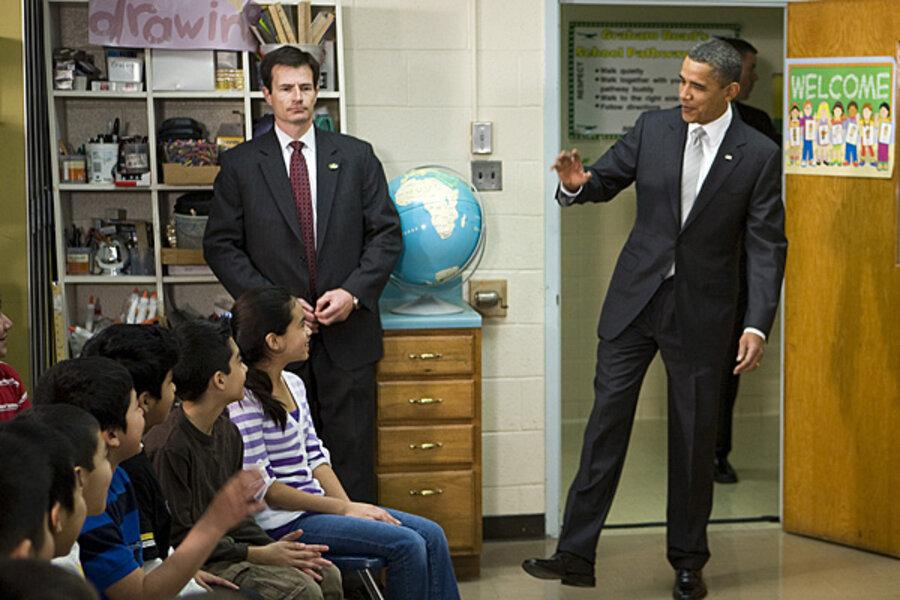How Race to the Top is recasting education reform in America
Loading...
New York is more than doubling its number on charter schools and will tie teacher evaluations to student performance.
Colorado passed a major overhaul of teacher tenure and evaluation rules, despite fierce union opposition.
And Louisiana teachers will be subject to more rigorous evaluation, after a law the legislature pushed through last week.
As states submit their applications Tuesday for Round 2 of the Obama administration's Race to the Top education grants, several states have taken major actions to try to be more competitive. At the same time, a handful have dropped out, either over disagreement about the framework of the competition or after a failure to get the reforms needed to have a shot at a piece of the $4.3 billion pot of federal money.
The nationwide churn on education reform shows how much mileage the administration has gotten out of a relatively small pot of money – permanently changing the reform agenda in the US as a result, experts say. In addition, Race to the Top seems to be giving many states the political cover they need to push through reforms unpopular with unions.
“There are some really important things going on,” says Charles Barone, director of federal policy for Democrats for Education Reform. “Which is not to say that every state succeeded…. But in every state we at least saw some ice breaking” in the conversation around education.
Round 2: Here we go again
Race to the Top was already the impetus for a rash of major education reforms late last year in advance of the January application deadline. After just two winners – Delaware and Tennessee – were announced in March, many states voiced dissatisfaction with the process. Some observers said the choice demonstrated that states needed substantial union buy-in to be considered.
Delaware and Tennessee were widely seen as having weaker applications than several other states – like Florida and Louisiana – but had better buy-in from unions and districts.
This time around, the Education department has promised to award more states (around 15). But some states have already decided it’s not worth it to apply. Nine states that applied the first time – Minnesota, Virginia, Kansas, West Virginia, Indiana, Wyoming, South Dakota, Oregon, and Idaho – are sitting on the sidelines for Round 2. [Editor's note: The original list of states in this paragraph contained one too many states. Oklahoma is taking part in the second round of applications.]
Minnesota and Indiana went through contentious battles with unions and ultimately failed to get the support they felt they needed to be competitive. Several other states worried about giving up local control. And in Virginia, Gov. Robert McDonnell (R) called the program “overly prescriptive” and said that the state’s standards were more rigorous than the national standards he would need to agree to adopt to make Virginia a contender.
That last reason has been a major point of contention for Massachusetts, as well. The state was docked 15 points in their Round 1 application for not agreeing to sign onto the Common Core standards (which will be launched Wednesday). Massachusetts officials say their current state standards – arguably the toughest in the country – are far more rigorous.
“It’s a serious concern,” says Grover “Russ” Whitehurst, director of the Brown Center on Education Policy and a senior fellow at the Brookings Institution. “There’s about six weeks between the release of the standards and the need to commit to them in the Race to the Top application, which is a perilously short period for any reasoned reflection… The timetable here is grossly unreasonable.”
Big promises, but realistic?
Mr. Whitehurst also says some states may make more big promises this time: In the first round, states that offered realistic assessments seemed to be punished, he says, while those with ambitious goals – even if unrealistic – were rewarded.
Many of the new laws address teacher evaluations and link them to student test scores, says Jack Jennings, president of the Center on Education Policy. “It’s a very basic change. It goes to whether teachers are retained, and may go to how they’re paid,” he says.
In theory, Mr. Jennings adds, such evaluations could help. But he worries that the changes are being pushed through before there are good enough tests to judge a teacher’s impact.
“What they’re doing is pushing so hard – and not investing the money in changing the tests – that they may discredit the reform,” he says.
Related:





